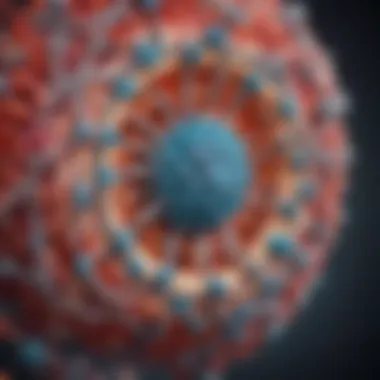Exploring PDB Proteins: Structure and Applications


Intro
The Protein Data Bank (PDB) serves as a pivotal repository for understanding proteins at a structural level. Proteins are essential macromolecules that play crucial roles in virtually every biological process. Their structures determine their functions, which range from catalyzing biochemical reactions to providing structural support in cells. The PDB offers a wealth of information about protein structures, which is crucial for several fields, including biotechnology and pharmacology.
Understanding the intricate details of protein structures allows researchers to unlock new drug design strategies, enhance biotechnological applications, and forge pathways toward innovative therapeutic solutions. In this article, we will dissect PDB proteins, exploring their structural characteristics, biological significance, and diverse applications in science. Delving into the research surrounding protein data, we aim to present a coherent narrative that highlights the relevance of PDB in advancing scientific knowledge and practical applications.
Research Overview
Summary of Key Findings
The PDB plays an indispensable role in protein research, hosting thousands of protein structures that have been elucidated through various methodologies. The availability of this data helps researchers gain insights into how proteins function and interact within the biological systems. Key findings from recent research include a better understanding of protein folding mechanisms and the identification of new targets for drug design. This growing database allows for the continual refinement of models and predictions concerning protein behavior.
Methodologies Employed
Multiple techniques are employed to determine protein structures, notably X-ray crystallography, NMR spectroscopy, and cryo-electron microscopy. Each method has its strengths and limitations, which influence the types of proteins that can be analyzed.
- X-ray Crystallography provides high-resolution structure insights but requires crystallization of proteins, which is sometimes challenging.
- NMR Spectroscopy is effective for analyzing proteins in solution but is limited to smaller proteins due to complexity.
- Cryo-Electron Microscopy allows for studying larger complexes and aggregates but with lower resolution compared to crystallography.
Through these methods, the PDB has amassed an extensive collection of structural data that underpins ongoing research efforts.
In-Depth Analysis
Detailed Examination of Results
A detailed examination of the available data reveals how the structural diversity of proteins correlates with their functional versatility. Popular protein families, such as enzymes and receptors, exhibit a range of structural adaptations that allow for specific interactions with substrates or ligands. These structures provide key insights into evolutionary biology and functional genomics, further emphasizing the significance of the PDB as a scientific resource.
Comparison with Previous Studies
Prior studies have often focused on isolated proteins or specific pathways. However, the PDB facilitates a more holistic view of protein networks and interactions, which was not easily achievable before its establishment. By comparing contemporary findings with earlier models, researchers can assess progress in structural biology and explore how newer methodologies have advanced the field.
"The exploration of protein structures not only illuminates biological mechanisms but also drives biopharmaceutical innovation and research development."
Prelude to PDB Proteins
Understanding PDB proteins is crucial for both scientific and research communities. The Protein Data Bank (PDB) serves as a central repository for protein structures, where researchers globally can access detailed information on proteins. This access is essential for advancing biological knowledge and practical applications in fields such as drug design and biotechnology.
Definition and Significance of PDB
The Protein Data Bank (PDB) is an organized database that collects and stores three-dimensional structures of proteins, nucleic acids, and complex assemblies. This information is vital because it allows scientists to visualize the molecular architecture of biomolecules based on experimental data. PDB data supports a wide array of research and applications, providing insights into protein function, interactions, and mechanisms. In drug development, for example, researchers use PDB structures to identify potential drug targets and design effective molecules that can interact with these targets.
Historical Background
The establishment of the PDB dates back to 1971, initially as a resource for crystallographers. Over the years, it has evolved dramatically. The addition of NMR and cryo-electron microscopy data has expanded its utility. As of 2023, the database contains over one million entries, a testament to the rapid advancement in structural biology. The PDB not only serves as a reference but also facilitates collaboration among scientists. By being open-access, it encourages sharing knowledge across various scientific disciplines, which is instrumental in accelerating discoveries.
Structure of PDB Proteins
The structure of PDB proteins holds significant importance in the understanding of their functions and applications. A protein's structure directly influences its biological role and interaction with other molecules. By dissecting the various levels of protein structure—primary, secondary, tertiary, and quaternary—researchers and professionals can gain insights into the mechanisms governing biological processes.
Understanding the structure of proteins can lead to advancements in drug design, biotechnology, and numerous other fields. For instance, knowing how a protein folds can inform researchers about potential binding sites for drug development. Furthermore, the structural data available in the PDB (Protein Data Bank) helps unify the scientific community, allowing for collaboration and sharing of knowledge.
Primary Structure
The primary structure of a protein refers to its unique sequence of amino acids. This sequence is determined by the genetic code and is fundamental in defining the protein's properties and functions. Each protein consists of a chain of amino acids connected by peptide bonds, forming its backbone.


The significance of primary structure can not be understated, as any alterations or mutations in this sequence can drastically change a protein's shape and function. The primary structure serves as a blueprint that dictates how a protein will fold into its higher levels of structure, ultimately influencing its role in cellular processes. In the context of PDB proteins, the ability to analyze and characterize these sequences aids in understanding evolution and aiding in biomolecular research.
Secondary Structure
Secondary structure refers to localized conformations of the protein backbone, predominantly stabilized by hydrogen bonds. The most common forms are alpha-helices and beta-sheets. These structures emerge from interactions among the backbone atoms of the amino acids and play crucial roles in maintaining the protein's integrity.
Identifying the secondary structure is essential for understanding how proteins interact with each other and their environment. For example, certain motifs found within secondary structures can be indicative of a protein's function or familial relationship to other proteins. The visualization of secondary structures in the PDB helps researchers to predict functionalities based on structural similarity to previously studied proteins.
Tertiary Structure
The tertiary structure is the overall three-dimensional shape of a protein, formed by the folding of its secondary structures into a compact structure. This folding is stabilized by various interactions, including hydrophobic interactions, ionic bonds, and disulfide bridges.
The tertiary structure is critical because it determines the protein's active sites and binding capabilities with other biomolecules. A clear understanding of tertiary structure can facilitate the development of therapies targeting specific proteins, making this knowledge invaluable in fields like structural biology and cyclic peptide research. Resources like the PDB provide essential data that researchers use to understand biologically relevant interactions at this level.
Quaternary Structure
Quaternary structure pertains to the assembly of multiple polypeptide chains (subunits) into a single functional complex. Not all proteins exhibit quaternary structure; however, many that do rely on this multiprotein assembly for their functionality. Examples include hemoglobin and antibodies.
The significance of studying quaternary structure lies in appreciating the cooperative interactions among subunits. Understanding how these complexes form and operate can unlock insights into disease mechanisms and lead to innovative therapeutic strategies. The PDB's extensive database allows for detailed exploration of these multimeric proteins, providing key data for various research and development endeavors.
"Grasping the structure of proteins is akin to understanding a language in molecular form; each structure tells a story of its functionality and biological relevance."
Methods of Structural Determination
Understanding the structural characteristics of proteins is crucial, as these structures dictate function and interaction within various biological systems. The methods used for determining protein structure have evolved significantly over the years. Each technique offers unique benefits, challenges, and insights into the molecular architecture of proteins recorded in the Protein Data Bank (PDB). The accuracy and detail provided by these methods are vital, especially for applications in drug design and biotechnology.
X-ray Crystallography
X-ray crystallography has long been the gold standard for protein structure determination. This method involves crystallizing a protein and then analyzing the diffraction pattern obtained when X-rays interact with the crystal. These diffraction patterns provide a three-dimensional picture of the protein at atomic resolution.
One significance of using X-ray crystallography is its ability to produce highly detailed structural data. Researchers can visualize the arrangement of atoms within the protein and understand the interactions with other molecules. However, there are considerations for using this method. For instance, not all proteins can be easily crystallized, which can limit its applicability in specific cases.
In addition, the method may also impose constraints in terms of the protein's natural state, as crystallization may not accurately reflect the protein's behavior in solution.
Nuclear Magnetic Resonance (NMR)
Nuclear Magnetic Resonance (NMR) is another prevalent technique used in structural determination. Unlike X-ray crystallography, NMR does not require crystallization, allowing for the study of proteins in solution. This can provide insights into the dynamic behavior of proteins, including conformational changes that molecules undergo.
One key advantage of NMR is its ability to study the dynamics and conformational changes in proteins. This dynamic information is particularly relevant in understanding how proteins interact with other molecules. However, NMR has limitations as well. It is generally less effective for larger proteins or complexes due to increased signal overlap and complexity.
Moreover, NMR provides lower resolution compared to X-ray crystallography, which can make it challenging to obtain precise structural details.
Cryo-Electron Microscopy
Cryo-electron microscopy (cryo-EM) has emerged as a valuable tool for protein structure determination, especially for large complexes that may be difficult to crystallize. This innovative technique involves rapidly cooling specimens to preserve their natural state and then using electron microscopy to visualize the structure.
Cryo-EM offers several advantages, such as the ability to analyze larger macromolecular complexes and membrane proteins that are typically challenging to study using other methods. It provides sufficient resolution for visualizing protein conformations and interactions in a near-native state. Still, only moderate resolution can be achieved compared to X-ray crystallography.
Additionally, the sample preparation for cryo-EM can be intricate, and the data processing methods require specialized skills and software. As with all techniques, researchers must carefully consider these factors when choosing the suitable methods for structural determination.
"Each of these methodologies contributes to the wealth of knowledge in the Protein Data Bank, enabling advancements in our understanding of protein function and interaction."
PDB Database Overview
The Protein Data Bank (PDB) serves as a pivotal repository for structural data of proteins and other biological macromolecules. Its importance in the realm of biochemistry cannot be overstated. By providing comprehensive and accurate structural data, it facilitates research across various scientific fields including biology, chemistry, and medicine. The PDB not only aids researchers in studying protein structures, but it also supports innovative applications in drug design, biotechnology, and many other domains. Understanding the PDB database's structure and contents grants researchers invaluable tools for analysis and application.


Accessibility and User Interface
Access to the PDB is crucial for researchers and educators alike. The user interface is designed to be intuitive, allowing users to easily navigate through the vast array of data available. The website offers tools to visualize protein structures and download structural files in various formats. This accessibility ensures that researchers at different levels of expertise can utilize the data effectively. The search function allows for both simple and advanced queries, helping users quickly locate specific proteins or structures relevant to their studies.
Data Formats and Metadata
The data within the PDB is stored in several formats, which are critical for different types of analyses. The most common format is the PDB format itself, which includes essential information about atomic coordinates, connectivity, and hierarchy of the protein structures. Besides this, the PDB also offers files in mmCIF format, which caters to users needing more extensive metadata. Metadata associated with each entry provides crucial contextual information like experimental methods, resolution, and structural validation data. This wealth of metadata allows researchers to understand not only the structure but also the circumstances around its determination.
Data Retrieval and Search Tools
Efficient data retrieval is an essential feature of the PDB. Several search tools are available, allowing users to filter data based on various criteria such as protein name, function, or even specific mutations. The advanced search options permit users to employ Boolean operators and other sophisticated filtering methods to narrow down results effectively. These tools are supported by a robust backend that ensures quick access to the desired data, enabling researchers to spend less time searching and more time analyzing.
"The ease of access to structural data enhances our ability to conduct research that can lead to breakthroughs in understandings of disease and treatments."
The integration of these various features within the PDB database streamlines research and educational endeavors, making it an indispensable asset for scientists across fields.
Applications of PDB Proteins
The exploration of PDB proteins holds numerous important applications, significantly enhancing both therapeutic strategies and biotechnological procedures. PDB proteins serve as crucial models and references in various scientific disciplines, primarily through their structural data derived from the Protein Data Bank. This section will delve into two major applications: drug design and development, and biotechnology innovations.
Drug Design and Development
The field of drug design has been fundamentally transformed by insights gained from PDB proteins. Structure-based drug design relies heavily on detailed structural information from the PDB. By understanding the three-dimensional conformations of target proteins, researchers can design small molecules that precisely interact with these targets. Several pivotal considerations include:
- Target Identification: PDB proteins allow researchers to identify potential targets for drug discovery by providing structural insights into disease-related proteins.
- Molecular Docking: Utilizing software tools, scientists can simulate how drugs bind to these proteins, thereby predicting the efficacy before experimental validation.
- Structure-Activity Relationship (SAR): Knowledge from PDB aids in analyzing how changes in drug structure impact biological activity, guiding modifications for optimal effectiveness.
- Lead Optimization: Once promising compounds are identified, iterative testing can enhance their properties, minimizing side effects while maximizing therapeutic gain.
Through these methodologies, numerous drugs have been designed, ranging from antiviral agents to anticancer therapies, showcasing the direct influence of PDB proteins on novel pharmaceutical developments.
Biotechnology Innovations
In biotechnology, PDB proteins play an essential role in the development of novel technologies and products. The applications manifested in this field include but are not limited to:
- Enzyme Engineering: By utilizing structural data, researchers can create engineered enzymes with enhanced activities, specificity, or stability tailored for industrial processes.
- Vaccine Development: Structural knowledge of viral proteins assists in the design of vaccines by identifying epitopes that elicit strong immune responses.
- Synthetic Biology: PDB proteins inform the design of synthetic pathways for the production of valuable compounds, including biofuels and pharmaceuticals.
- Diagnostics: Protein structures help in the development of diagnostic tests by enabling the design of specific antibodies that recognize particular proteins associated with diseases.
"The structural biology knowledge derived from the PDB is not just a repository of data; it is a catalyst for innovation across diverse scientific domains."
The integration of PDB proteins into biotechnology exemplifies how structural biology informs practical applications that address real-world challenges. Advancements are consistently transforming industry practices, demonstrating the vast potential of utilizing detailed protein data in innovative ways.
Impacts on Scientific Research
Understanding PDB proteins plays a crucial role in the scientific research community. The Protein Data Bank offers wealth of information that informs scientists about protein structures and functions. This advances several domains of biological research and informs various practical applications. Researchers rely on accurate 3D structures from PDB to guide experimental design, investigate biomolecular mechanisms, and develop new therapeutics.
Advancements in Molecular Biology
Molecular biology has benefitted immensely from PDB's resources. The availability of high-resolution protein structures has facilitated groundbreaking discoveries in gene expression, regulation, and interactions. For instance, researchers can elucidate protein complexes and the dynamics of molecular interactions. This information is pivotal for understanding how proteins collaborate to perform cellular functions. Researchers have used PDB data to identify active sites in enzymes and receptors, guiding the design of drugs that target these sites with higher specificity.
Furthermore, the integration of PDB data into molecular modeling and simulation tools has accelerated research. Biophysical methods combined with PDB structures allow scientists to predict how proteins fold and interact under different conditions, thus enhancing the knowledge of protein behavior in biological systems. This context aids not just basic research but also the development of practical applications including genetic engineering and therapeutic interventions.
Significance in Structural Biology
In structural biology, PDB proteins serve as fundamental references. The repository has housed detailed structures that illuminate the function of various proteins. For example, the structures of hemoglobin and antibodies have provided insights into their roles in oxygen transport and immune response. Studying these proteins in detail leads to a better understanding of their transformations and roles in larger biological pathways.
With the significance of structural data, researchers can probe into disease mechanisms. Mutations that affect protein folding or stability can be analyzed against known structures, revealing potential pathways to target for therapeutic intervention.
"The insights gained from PDB data can pave the way for innovations in both biotechnology and medical science."


Moreover, PDB contributes to educational resources in structural biology. Students and professionals consult it not only for research but also to visualize protein structures and learn through practical examples. This accessibility democratizes knowledge and fosters collaborations across various disciplines.
Through the continuous updates in the PDB database, researchers can analyze emerging structural data alongside historical information. This ongoing accumulation of knowledge fuels scientific inquiry, leading to novel findings in health, disease, and biochemistry.
Future Directions for PDB Research
Emerging Techniques
As PDB protein research continues to evolve, emerging techniques are crucial in the quest for understanding complex protein structures and functions. Advances in methods such as cryo-electron microscopy and micro-crystal electron diffraction are pivotal. For instance, cryo-electron microscopy has significantly improved the resolution at which researchers can visualize proteins. This method allows scientists to observe proteins in their near-native state, offering insights into dynamics that traditional methods like X-ray crystallography may overlook. The ability to capture real-time protein interactions enhances the understanding of biological processes.
Furthermore, techniques like single-particle reconstruction are gaining traction. This method involves isolating individual protein complexes to reconstruct three-dimensional models. As a result, it facilitates the study of large macromolecular assemblies that were previously challenging to analyze. In conjunction with existing techniques, these advancements offer a more comprehensive understanding of protein behaviors in various environments.
Additionally, high-throughput sequencing and mass spectrometry are shaping future research directions. These methods enable the rapid analysis of protein interactions and modifications, making it possible to explore the proteomics landscape more efficiently. The integration of these emerging techniques propels PDB research into a new realm of scientific inquiry, ultimately enhancing our knowledge of protein biology.
Integration with Artificial Intelligence
The integration of Artificial Intelligence (AI) into PDB research represents a transformative approach to protein analysis. AI models, particularly deep learning algorithms, have shown promise in predicting protein structures with remarkable accuracy. These models leverage vast datasets, including PDB entries, to recognize patterns that may not be evident to human researchers. This capability not only accelerates the process of structural determination but also opens avenues for discovering novel proteins and their functions.
Machine learning techniques are also effective in molecular docking simulations. By predicting how different molecules, including potential drugs, might interact with protein targets, these models can dramatically streamline drug discovery processes. This integration could lead to more effective therapies with fewer side effects.
Moreover, AI aids in analyzing vast amounts of biological data generated from different experiments. As researchers increasingly rely on big data, AI tools are essential in sifting through this information, identifying key insights, and facilitating informed decision-making.
The future of PDB research thus hinges on the symbiosis of traditional techniques and AI innovations. This intersection not only enhances our understanding but also paves the way for breakthroughs in drug development and personalized medicine.
In summary, the convergence of emerging techniques and artificial intelligence in PDB research holds the potential to revolutionize our understanding of protein structures and functions, ultimately driving advancements in various scientific fields.
The End
The conclusion serves as a crucial part of this article, encapsulating the core insights into PDB proteins. It ties together all the elements discussed across the sections, solidifying the importance of understanding protein structures, functions, and their wide-ranging applications. The Protein Data Bank represents a cornerstone of structural biology, offering data that is essential for research across multiple scientific domains.
Summation of Key Points
In summarizing the key points, it is important to reflect on several critical aspects:
- Definition and Importance: PDB proteins are vital for comprehending biological mechanisms and enabling breakthroughs in medical and biotechnological fields.
- Structural Framework: Understanding the primary, secondary, tertiary, and quaternary structures provides insight into how proteins function at cellular and molecular levels.
- Research Methods: Techniques such as X-ray crystallography, NMR, and cryo-electron microscopy are foundational for determining protein structures, offering researchers tools for analysis and discovery.
- Databases and Tools: The PDB database facilitates easy access to a wealth of information, empowering research with user-friendly search tools and comprehensive data formats.
- Applications in Science: The applications in drug design and biotechnology highlight the translational aspect of structural knowledge. They illustrate how fundamental research can lead to practical solutions in healthcare and industry.
- Future Directions: As research continues to evolve, integrating artificial intelligence and advanced methodologies promises to push the boundaries further in uncovering the complexities of proteins.
Final Thoughts on the Role of PDB
The Protein Data Bank not only archives knowledge but also acts as a catalyst for innovation. Its role extends beyond mere data; it serves as a foundation upon which future scientific advances can be built. Researchers rely heavily on PDB to inform their hypotheses, expedite discoveries, and foster interdisciplinary collaborations.
As themes of molecular biology and structural biology burgeon, the PDB will remain indispensable. It is a critical resource that nourishes scientific inquiry and invites exploration into the marvels of protein structures. The continued investment in and utilization of PDB resources will likely yield significant scientific returns, enhancing our understanding of life at the molecular level. Thus, appreciating the role of PDB is essential for anyone engaged in foundational or applied research.
Citing PDB Resources
Citing PDB resources accurately is paramount. The Protein Data Bank maintains a standardized format for citing structures, which includes information such as the PDB ID, authors, and publication details. Here’s how you might format a citation:
- PDB ID: 1XYZ
- Authors: Smith J, Doe A.
- Title: Structure of Protein X.
- Journal: Journal of Proteins. Year; Volume: Pages.
Each citation should align with the style guide relevant to the field of study, whether it is APA, MLA, or Chicago. Understanding these conventions aids in proper attribution and fosters professional integrity.
Further Reading
Further reading enhances one's comprehension of the PDB and its vast applications. Numerous resources exist for researchers and students seeking to deepen their understanding. Recommended materials include:
- Books:
- Online Resources:
- Introduction to Protein Structure by Branden C.
- Discovering the PDB: A User’s Guide by D.W. Sussman.
- Protein Data Bank official website: rcsb.org
- Wikipedia: Protein Data Bank
- Scientific articles available through platforms like ResearchGate or Google Scholar.
By pursuing further education through these texts and resources, one can grasp the complex interplay between protein structure, function, and their applications in various fields. Staying abreast of recent publications and ongoing studies is essential for a nuanced understanding of the PDB’s contributions.















